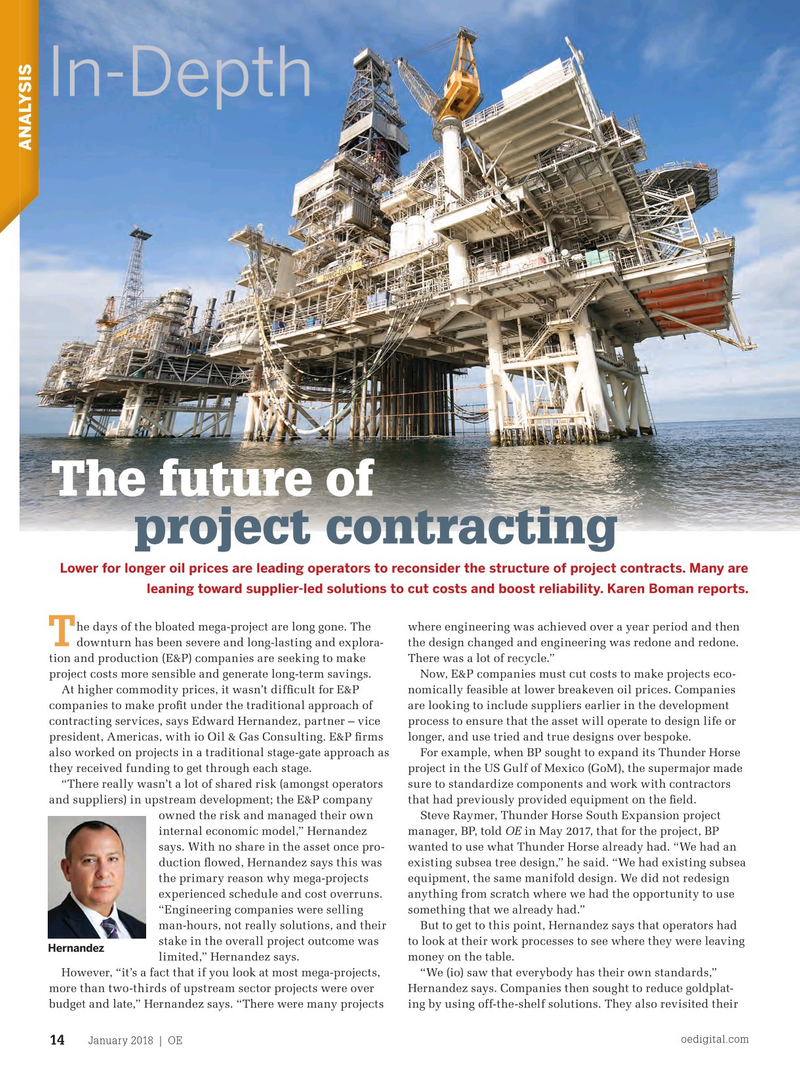
Page 12: of Offshore Engineer Magazine (Jan/Feb 2018)
Read this page in Pdf, Flash or Html5 edition of Jan/Feb 2018 Offshore Engineer Magazine
In-Depth
ANALYSIS
The future of project contracting
Lower for longer oil prices are leading operators to reconsider the structure of project contracts. Many are leaning toward supplier-led solutions to cut costs and boost reliability. Karen Boman reports.
he days of the bloated mega-project are long gone. The where engineering was achieved over a year period and then
T downturn has been severe and long-lasting and explora- the design changed and engineering was redone and redone. tion and production (E&P) companies are seeking to make There was a lot of recycle.” project costs more sensible and generate long-term savings. Now, E&P companies must cut costs to make projects eco-
At higher commodity prices, it wasn’t dif? cult for E&P nomically feasible at lower breakeven oil prices. Companies companies to make pro? t under the traditional approach of are looking to include suppliers earlier in the development contracting services, says Edward Hernandez, partner – vice process to ensure that the asset will operate to design life or president, Americas, with io Oil & Gas Consulting. E&P ? rms longer, and use tried and true designs over bespoke. also worked on projects in a traditional stage-gate approach as For example, when BP sought to expand its Thunder Horse they received funding to get through each stage. project in the US Gulf of Mexico (GoM), the supermajor made “There really wasn’t a lot of shared risk (amongst operators sure to standardize components and work with contractors and suppliers) in upstream development; the E&P company that had previously provided equipment on the ? eld.
owned the risk and managed their own Steve Raymer, Thunder Horse South Expansion project internal economic model,” Hernandez manager, BP, told OE in May 2017, that for the project, BP says. With no share in the asset once pro- wanted to use what Thunder Horse already had. “We had an duction ? owed, Hernandez says this was existing subsea tree design,” he said. “We had existing subsea the primary reason why mega-projects equipment, the same manifold design. We did not redesign experienced schedule and cost overruns. anything from scratch where we had the opportunity to use “Engineering companies were selling something that we already had.” man-hours, not really solutions, and their But to get to this point, Hernandez says that operators had stake in the overall project outcome was to look at their work processes to see where they were leaving
Hernandez limited,” Hernandez says. money on the table.
However, “it’s a fact that if you look at most mega-projects, “We (io) saw that everybody has their own standards,” more than two-thirds of upstream sector projects were over Hernandez says. Companies then sought to reduce goldplat- budget and late,” Hernandez says. “There were many projects ing by using off-the-shelf solutions. They also revisited their oedigital.com
January 2018 | OE 14 014_OE0118_inDepth_Analysis.indd 14 12/27/17 1:51 PM

 11
11

 13
13